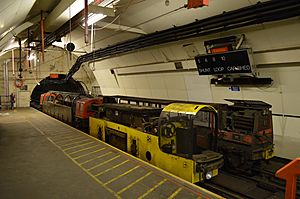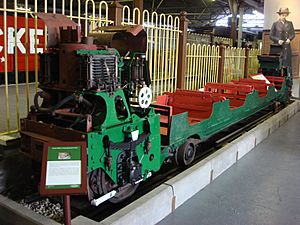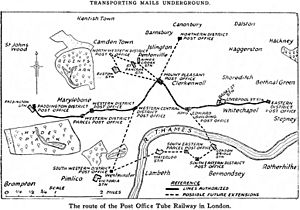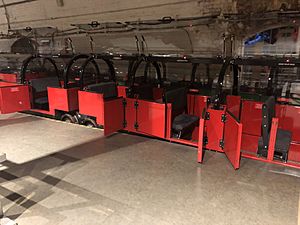London Post Office Railway facts for kids
Quick facts for kids London Post Office Railway |
|
|---|---|

Mail Rail trains at a platform
|
|
| Overview | |
| Status | Closed; partially re-opened as museum |
| Owner | Royal Mail |
| Locale | London, England |
| Termini | Paddington Sorting Office Whitechapel Eastern Delivery Office |
| Stations | 9 |
| Service | |
| Type | Private industrial railway |
| Services | 1 |
| Depot(s) | Mount Pleasant |
| Rolling stock | 1980 Greenwood & Batley |
| History | |
| Opened | 3 December 1927 |
| Closed | 31 May 2003 |
| Technical | |
| Line length | 6.5 miles (10.5 km) |
| Track gauge | 2 ft (610 mm) |
| Loading gauge | Custom gauge |
| Electrification | 440 V DC Third rail |
| Operating speed | 40 mph (64 km/h) through core tunnels; 7 mph (11 km/h) through stations, platforms and loops |
| Highest elevation | 70 feet (21 m) below street level |
The Post Office Railway was a special underground train system in London. It was a small railway built by the Post Office to carry mail, like letters and packages, between different sorting offices. This railway was unique because it was completely driverless! It started running in 1927 and worked for 76 years until 2003. Today, part of it is a cool museum that opened in 2017.
Contents
Journey Through London's Underground
The Post Office Railway ran from the Paddington sorting office in the west to the Whitechapel office in the east. This journey covered about 6.5 miles (10.5 km) across London.
The railway had eight stations at its busiest. The biggest station was located under the Mount Pleasant building. By 2003, only three stations were still in use. This was because the mail sorting offices above the other stations had moved.
Building the Secret Mail Route
How the Railway Was Built
In 1911, people realized that London's roads were getting too busy. Mail was being delayed, so a plan was made to build an underground railway. This railway would be 6.5 miles (10.5 km) long. It would connect major mail sorting offices from Paddington to Whitechapel.
The company John Mowlem and Co won the job to build the tunnels. Construction began in February 1915. Most of the main tunnels were dug using a special machine called a Greathead shield. Smaller connecting tunnels at stations were dug by hand.
The main railway line has a single tunnel that is 9 feet (2.7 meters) wide. Inside this tunnel, there are two tracks. Just before the stations, the tracks split into two smaller tunnels. These tunnels are 7 feet (2.1 meters) wide and lead to the station platforms.
The main tunnel is about 70 feet (21 meters) deep underground. However, the stations are much closer to the surface. The tracks go down a gentle slope of 1 in 20 to reach the stations. This slope helped trains slow down as they arrived and speed up as they left. It also meant mail didn't have to be lifted as far to the street level. Near Oxford Circus, the Post Office Railway tunnel runs close to the Bakerloo line of the London Underground.
Work on the railway stopped in 1917 because of World War I. There weren't enough workers or materials. By June 1924, the tracks were being laid. In February 1927, the first part of the railway was ready for training. The railway officially opened for Christmas parcels in 1927. Letters started being carried in February 1928.
In 1954, a new mail office was planned at Rathbone Place. This meant a part of the railway had to be moved. The new section opened in 1958. On August 3, 1965, the new station and office were opened by Tony Benn, who was the Postmaster General. The old, unused part of the tunnel was then used for storage. Some of the tracks are still there today.
End of an Era
Why the Railway Closed
In April 2003, Royal Mail announced that the railway would close at the end of May. Royal Mail said that using the railway was five times more expensive than sending mail by road. However, the Communication Workers Union disagreed. They said it was only three times more expensive. They believed this was because the railway was not being used to its full potential.
A report from the Greater London Authority supported keeping the railway open. It said the railway carried about four million letters and parcels every day. The report also warned that closing it would mean 80 more truckloads of mail on London's roads each week. Despite these concerns, the railway closed on May 31, 2003.
Exploring the Tunnels Today
In 2011, a group of urban explorers shared photos and stories of getting into the tunnels. They showed that the railway was still in good condition, even after being closed for years. Later, media were allowed into the tunnels to promote the new Postal Museum. Their photos also showed that most of the railway's equipment was still in place.
A team from the University of Cambridge is using a small part of the unused tunnel near Liverpool Street Station. A new tunnel for the Crossrail project is being built just below it. The Cambridge team is studying how the old cast-iron tunnel linings react to the new construction. They use Digital cameras, special sensors, and laser scanners. These tools help them understand how the old materials behave. They can also give an early warning if the new tunnels are causing too much ground movement.
A New Life for the Mail Rail
In October 2013, the British Postal Museum & Archive announced plans to open part of the railway to the public. Islington Council approved the plans. Work on the new museum and railway started in 2014. Special trains for tourists were installed in late 2016.
The plan was to open a circular route under the Mount Pleasant depot. The ride would last about 15 minutes. The museum officially opened on September 5, 2017. In its first year, the trains made 9,000 trips, covering over 6,213 miles (10,000 km). The railway and museum welcomed over 198,000 visitors.
The Trains of the Mail Rail
The first trains for the Post Office Railway arrived in 1926. All the trains used on the system were powered by electricity.

Electric Locomotives
- 1926 Electric Locomotives — These were the first engines used on the railway.
Electric Units
- 1927 Stock — The original trains.
- 1930 & 1936 Stock — These trains replaced the 1927 Stock.
- 1962 Stock — A test model of a new train.
- 1980 Stock — The final trains used on the railway.
Some of these old trains have been saved and can be seen at the Launceston Steam Railway.
Mail Rail in Stories
The Post Office Railway has appeared in many books and films:
- In the novel The Horn of Mortal Danger by Lawrence Leonard, the railway connects to a secret train network.
- A version of the railway is in The Great Game by Lavie Tidhar. It delivers mail to Buckingham Palace.
- The film Hudson Hawk shows a similar mail train system in the Vatican City. Bruce Willis's character hides in a mail container.
- A mail train system like this is in Charlie Higson's Young Bond book, Double or Die.
- The railway is important in Oliver Harris's 2014 book Deep Shelter.
- It also features in Mark Leggatt's 2016 novel The London Cage.
- The railway appears in Adrian Tchaikovsky's 2020 novel The Doors of Eden.
Other Underground Mail Systems
The London Post Office Railway wasn't the only underground mail system. Here are a few others:
- London (1863-1874): The Post Office in London used a pneumatic railway. This system moved individual capsules with wheels using air pressure.
- Munich, Germany (1910-1988): A 450-meter (1,476 ft) tunnel railway opened in Munich. It connected the main train station to a nearby post office. It closed in 1988.
- Zürich, Switzerland (1938-1980): The Post-U-Bahn (underground railway) in Zürich was 340 meters (1,115 ft) long. It carried mail between the main train station and the main post office. It closed in 1980.
- Chicago, USA (1906-1959): The Chicago Tunnel Company had a huge network of 2-foot (610 mm) narrow gauge tracks. These tunnels ran under the city streets. They delivered freight, parcels, and even coal.
See also
- Subterranean London
- List of British heritage and private railways
- Travelling Post Office
- London Underground
- Royal Mail



